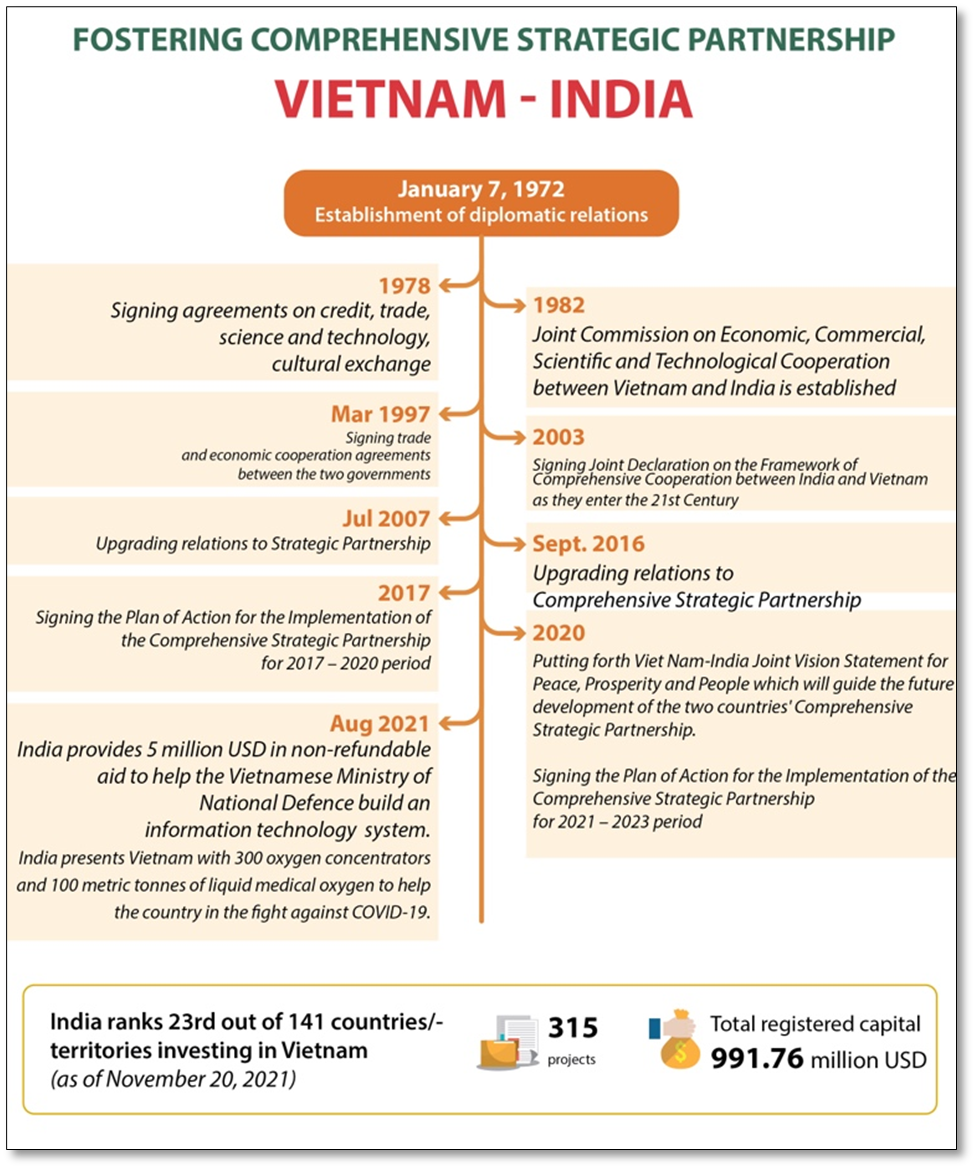Thursday, 16th June 2022
Migration in India 2020-21 Report
In News
Ministry of Statistics and Programme Implementation (MoSPI), has recently released the ‘Migration in India 2020-21’ report.
About the News
- The report, which is based on first-time collection of additional data during the annual round of Periodic Labour Force Survey for July 2020-June 2021, separates the categories of ‘temporary visitors’ and ‘migrants’.
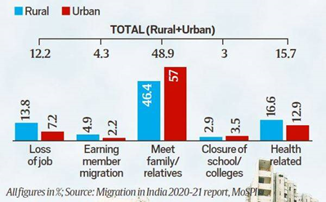
- While ‘temporary visitors’ have been defined as the ones who arrived in households after March 2020 and stayed continuously for a period of 15 days or more but less than 6
- ‘Migrants’ have been defined as those, for whom the last usual place of residence, any time in the past, is different from the present place of enumeration.
Highlights of the Report
- Temporary Visitor: The report notes that around 7% of the country’s population was a ‘temporary visitor’ in households during July 2020- June 2021 after the onset of Covid-19 pandemic in March 2020.

-
- 7% is male, female combined at all-India level and that percentage is in reference to the country’s population.
- Over 84% of these 0.7% moved places for reasons linked to the pandemic
- loss of job/closure of unit/lack of employment opportunities (2%),
- migration of earning member,
- closure of educational institutions and
- health related reasons (15.7%), and
- meeting family/relatives/friends (48.9%).
- All India Migration Rate: The all-India migration rate was 9% for July 2020-June 2021, with 26.5% migration rate in rural areas and 34.9% in urban areas.
- Females recorded a higher share of migration rate of 47.9%, with 48% in rural areas and 8% in urban areas.
- Among females, the highest level of migration rate was seen at 86.8% for marriage, while 6% of the males migrated in search of employment.
- During the same period, 9.2% persons migrated due to migration of parent/earning member of the family.
- The migration rate for males was seen at 7%, with 5.9% in rural areas and 22.5% in urban areas. Of the 9.2% persons who migrated due to migration of parent/earning member of the family, 17.5% were males.
- Reverse Migration: Reverse migration during the pandemic led to higher rates of unemployment agglomeration in rural areas, which caused rural distress.
Source:
- July 2020-June 2021: 0.7% of nation’s population was ‘temporary visitor’
- Explained: ‘Temporary visitors’ and ‘migrants’ — how they moved during the pandemic
Image source:
SIPRI Report on nuclear arsenal
In News
India had 160 nuclear warheads as on January 2022 and it appears to be expanding its nuclear arsenal, defence think tank The Stockholm International Peace Research Institute (SIPRI) claimed recently.
Global trends according to the report:
- During 2012-2021, military spending as a percentage of gross domestic product has largely been stable.
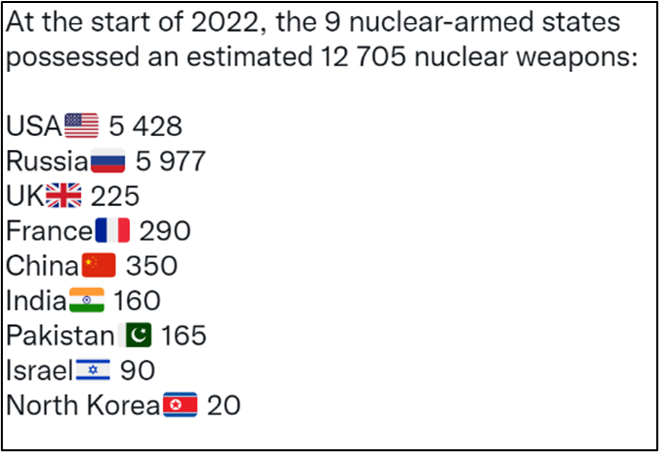
-
- If anything, the average worldwide trend has been slightly downward.
- Military modernisation is seen to be a global trend.
- All nuclear weapon owning states have, over the years, stated and worked upon their intention to modernise multiple facets of their armed forces—ranging from the development of newer and more efficient nuclear submarines, aircraft carriers, fighter jets, manned and unmanned aerial vehicles to the growing spread of the use of missile defence systems.
- It may result in aggravating security concerns for other countries.
Trends in India’s nuclear arsenal
- India’s nuclear stockpile increased from 156 in January 2021 to 160 in January 2022.
- The availability of reliable information on the status of the nuclear arsenals and capabilities of the nuclear-armed states varies considerably.
- India and Pakistan make statements about some of their missile tests but provide no information about the status or size of their arsenals.
Major concerns
- Some of the worrying indicators of an unstable system include low level border clashes between India and Pakistan, the civil war in Afghanistan, and the armed conflict in Myanmar.
- Three cause of concern trends: Chinese-American rivalry, involvement of state and non-state actors in multiple conflicts, and the challenge that climatic and weather hazards pose.
- The threat posed by climate change seems to feature in the report only nominally.
- The marginal downsizing observed in the nuclear arsenal has come mostly from the U.S. and Russia dismantling retired warheads.
- But the Russian invasion of Ukraine has raised some serious eyebrows because of the continuous rhetoric from the Kremlin over them not shying away from the use of nuclear weapons.
- China’s recent activities surrounding construction of 300 new nuclear missile silos is also concerning.
Way Forward
- The year 2021 saw the Treaty on the Prohibition of Nuclear Weapons, 2017 coming into effect.
- The Nuclear Suppliers Group (NSG) and the Missile Technology Control Regimes (MTCR) held their annual meetings despite decision making being limited due to the COVID-19 pandemic.
- Moreover, the leaders of the P5 countries (China, France, Russia, the U.K. and the U.S.) have affirmed that a nuclear war cannot be won and must never be fought.
- But the recent geopolitical events transpiring around the world in practically all regions have made the global security climate more unstable.
- The increasing nuclear arsenal of all the countries, Russian invasion of Ukraine and the subsequent NATO bids by Finland and Sweden seem to be telling events.
- A strong political opposition would be needed to help keep the ruling dispensation in check.
- Furthermore, the two largest nuclear weapons holding states need to take on a more engaging role in the international arena.
Sources:
New Map of Earth’s Tectonic Plates
In News
Researchers from the University of Adelaide, Australia, have carried out a new study titled ‘New maps of global geological provinces and tectonic plates’, that includes an updated map of the earth’s tectonic plates.
About the News
- This map of the Earth’s tectonic plate will help in better understanding of natural hazards like earthquakes and volcanoes.
- A tectonic plate, is a massive, irregularly shaped slab of solid rock, made up of lithosphere or the earth’s top layer whose movements often lead to earthquakes and volcanoes
Key Highlights of the Study:
- The study has delved into past construction of continents like first supercontinent, Vaalbara.
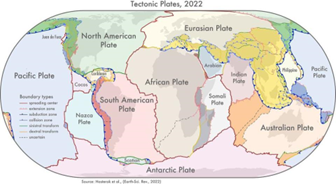
-
- Vaalbara fragmented to form other supercontinents over the years, the last being Pangea, which existed some 335-65 million years ago.
- Pangea again gave way to the seven modern continents which make the earth’s land surface today.
- Plate tectonics is a scientific theory that explains how major landforms are created as a result of Earth’s subterranean movements.
- The last time the tectonic plate model was updated was in 2003.
- The researchers have combined three models to map the new geological provinces and tectonic plates:

-
- A plate model based on the existing knowledge of tectonic plates.
- A province model based on the geological information of the earth’s surface.
- An orogeny model based on the process of mountain formation which is triggered when two tectonic plates collide.
- The New model includes several new microplates, including Macquarie microplate which sits south of Tasmania and Capricorn microplate that separates Indian and Australian plates.
- The biggest update to the existing plate model has been in western North America.
- The newly delineated boundary is much wider, approximately 1,500 km, than the previously drawn narrow zone.
- The other large change is in central Asia.
- The new model now includes all the deformation zones north of India as the plate bulldozes its way into Eurasia.
- Significance:
- It better explains the spatial distribution of 90% of earthquakes and 80% of volcanoes from the past two million years whereas existing models only capture 65% of earthquakes occurring along the plate boundaries.
- The plate model can be used to evaluate risks from natural hazards; the province model can be used for further exploration of minerals and the orogeny model for a better understanding of the evolution of the earth.
Source:
- New map of Earth’s tectonic plates to help understand quakes, volcanoes better
- New Study Shows Updated Map Of Earth’s Tectonic Plates
Image source:
Guru Arjan Dev martyrdom day - Edukemy Current Affairs
On 16 June 1606, Guru Arjan Dev, the fifth guru of Sikhs, was martyred. Born in 1563 in Goindval of Tarn Taran district, Guru Arjan Dev was the first martyr of the Sikh religion and was executed on the orders of Mughal emperor Jahangir.
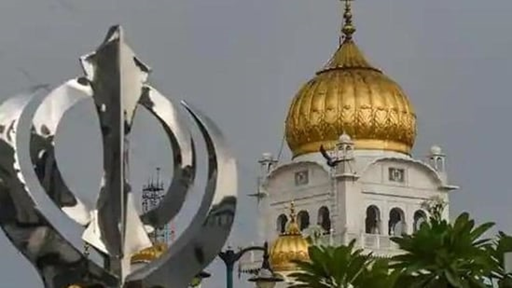
The Mughals were afraid of his increasing influence in northern India and the spread of Sikhism. He had compiled the first edition of the Sikh scripture Adi Granth, which is now known as Guru Granth Sahib. Every year, a batch of Sikh pilgrims, also known as jatha, travels to Pakistan to mark the martyrdom day of Guru Arjan Dev at Gurdwara Dehra Sahib in Lahore.
Source:
Banks Board Bureau (BBB) - Edukemy Current Affairs
- Context: The government is planning to introduce a new entity in place of the Banks Board Bureau (BBB).
- The new entity will have a wider and more legally tenable mandate to recommend candidates for appointments to senior management-level posts in state-run banks, insurance companies and other financial institutions.
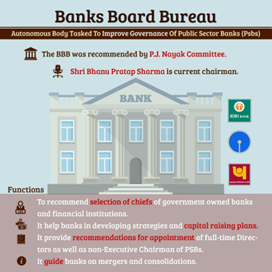
- The Banks Board Bureau (BBB) had its origin with the recommendations of ‘The P. J Nayak Committee to Review Governance of Boards of Banks in India, 2014.
- It was approved to be set up in 2016 to make recommendations for appointment of whole-time directors as well as non-executive chairpersons of Public Sector Banks (PSBs), state-owned financial institutions and government-owned insurance companies.
- However, the Ministry of Finance takes the final decision on the appointments in consultation with the Prime Minister’s Office.
- BBB is an autonomous recommendatory body and is a public authority as defined in the Right to Information Act, 2005.
Source:
- New entity with wider mandate to replace BBB
- New entity with wider mandate to replace BBB-Business Journal
Image source:
Plastic Pollution at Polar Region
- Context: Recently, researchers from University of Canterbury found an average of 29 particles of microplastics per liter of fresh melted snow in Antarctica.
- The most common variety was Polyethylene Terephthalate (PET), mostly found in plastic bottles and some cloths.
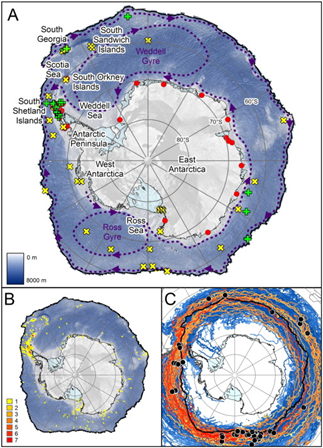
- This is the first instance of it being discovered in fresh snow.
- This is higher than what has previously been reported in the Ross sea shelf and Antarctic sea ice.
- Microplastics are small plastic pieces less than five millimeters long which can be harmful to oceans and aquatic life.
- Microplastics have negative impacts on the health of the environment, limiting growth, reproduction, and general biological functions in organisms, as well as negative implications for humans.
- Atmospheric modelling suggested microplastics may have travelled thousands of kilometres through the air, however it is likely that the presence of humans in Antarctica has established a microplastic 'footprint'.
- The Protocol on Environmental Protection to Antarctic treaty outlines rules on managing and treating waste, but currently waste water from Antarctic research stations is not treated and micro plastic levels are not monitored regularly.
Source:
- Scientists find microplastics in fresh Antarctic snow for the first time
- Microplastics found in fresh Antarctic snow for first time
Image Source:
Pradhan Mantri Aadi Adarsh Gram Yojana
- Context: Union Minister of Tribal Affairs has announced a scheme called " Pradhan Mantri Aadi Adarsh Gram Yojana" for faster development of tribal villages.
- The scheme is being implemented by the Ministry of Social Justice and Empowerment. The selected States are to select villages, or 2-3 contiguous districts (preference will be given to backward districts).
- The objective is to ensure integrated development of the selected villages into “model villages” - tagging of and market linkages through TRIFED.
- 740 Ekalavya Vidyalayas are being constructed in different parts of the country and efforts are on to improve the quality of learning and impart education. Women Empowerment through self-help groups are also being planned to be implemented.
- The scheme was launched in March, 2010 on a pilot basis for the integrated development of 1000 villages each with more than 50% SC population.
- The development of the villages has to be ensured through:
- Convergent implementation of existing Schemes of the Centre and State Governments, and
- The works which could not be covered under the above, to be taken up through provision of "gap-filling" funds for which central assistance is provided @ Rs. 10 lakh per village revised to 20 lakhs per village at an average w.e.f. Sep. 2011, with State Government also expected to make a suitable, preferably matching, contribution.
- Presently the scheme is being implemented in five States of the country viz Assam, Bihar, Uttar Pradesh, Rajasthan and Tamil Nadu.

Source:
- Govt launched Pradhan Mantri Aadi Adarsh Gram Yojana for faster development of tribal villages: Union Minister Arjun Munda
- Kalahandi to be included in PM Adi Adarsh Gram Yojana, says Union tribal affairs minister Arjun Munda
- Pradhan Mantri Adarsh Gram Yojana:
Image Source:
Lumpy skin disease - Edukemy Current Affairs
- Context: Some 1,229 cattle across five districts of Gujarat have been infected with Lumpy Skin Disease (LSD).
- LSD is an infectious viral disease.
- The disease is spread primarily by biting insects such as certain species of flies, mosquitoes and possibly ticks.
- The disease can also be spread by fomites through such things as contaminated equipment and in some cases directly from animal to animal.
- It does not pose a risk to human health.
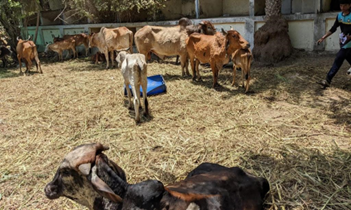
- Symptoms of LSD primarily consist of fever, fluid excretion from eyes and nose, dribbling of saliva from the mouth and blisters on the body.
- The animal stops eating and faces problems while chewing or eating, resulting in reduced milk production. If an animal is pregnant, the calf dies
- Vaccines are the only cure to an LSD epidemic. Hence, substantial measures to vaccinate cattle were being taken.
Sources:
Agnipath: Not the Armed Forces Reform
Essence: The structure of the military has immense ramifications for security, and also for social organisation at large. The Agnipath scheme is a major structural reform with consequences both for the armed forces and society at large.
The article talks about caution while bringing in reforms in the armed force. Populistic moves, for example recent reforms in OROP, create massive burden on the government exchequer. Also, the Agnipath scheme, through inexperienced soldiers, might not satisfy the two critical needs of the armed forces i.e. shift from reliance on personnel to technology, and a younger age profile of soldiers.
If you want to create new regimental cultures, sources of loyalty and discipline, you need longer terms of service together rather than shorter ones. Also, the scheme seems to be marketing the army as a skill development school. The idea of professional identity diminishes or is negligible where your service is so short. Also, what happens in the army has huge sociological implications, and if not handled well, we could be playing with fire.
The armed forces need support and reform. But reforms should be governed by a sound sociological, professional, institutional and strategic logic. As per the author, this scheme may fail the test on these four parameters.
Why should you read this article?
- To understand the concerns related to the Agnipath Scheme
- To understand the real needs of the armed forces
Source:
Free or Subsidized Distribution of Commodities: IE
Essence: Recently the Punjab government’s announcement of providing up to 300 units of free power to every household has raised questions regarding its definition of freebies and encouragement of the same.
In India, policymakers have drawn on budgetary resources for providing support to low-income households for augmenting their consumption of selected goods and services, and also offering incentives to support selected categories of investors and producers. The practice of providing certain goods or services free or at highly subsidised prices has been common in budgets.
The key question is to decide what commodities should be distributed free or at a subsidised level and what the level of subsidy should be. Subsidisation or the free provision of essential and merit goods can be justified on the grounds of meeting social objectives when the list of commodities expands to include such items as TV sets, serious doubts arise.
But it is also advisable to limit the distribution of commodities and services at highly subsidised levels to essential and merit goods. It is important that the schemes require to be carefully designed to avoid their misuse and minimise their costs. It is also important to consider a limit to the fiscal cost of undertaking such initiatives.
Why should you read this article?
- To understand what commodities should be distributed free or at a subsidised level and what the level of subsidy should be.
- To understand why schemes, require to be carefully designed to avoid their misuse and minimise their costs.
Source:
Empowering girls through education
Background
Taking inspiration from Maharshi Karve, Jameendar Babasaheb Keshav Narayanrao Deshmukh set up the Sanskriti Samvardhan Mandal (SSM), to start the first-ever residential school in Sagroli, Maharashtra committed to empowering girls through education.
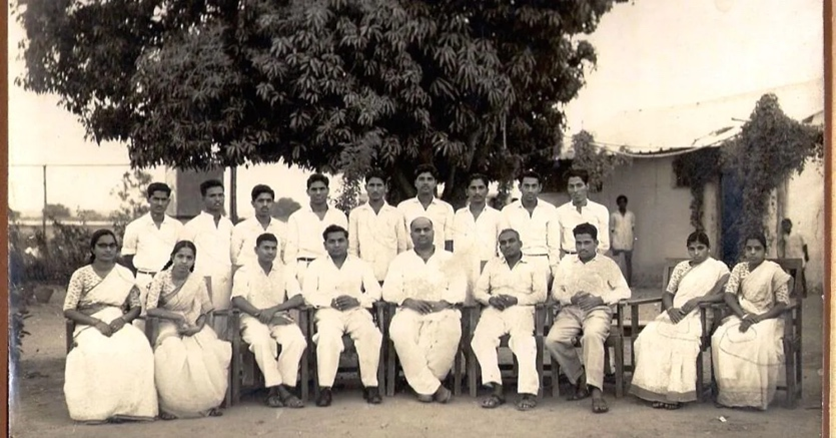
About the Initiative
- Babasaheb Keshav Narayanrao Deshmukh managed to study only till Class 10.
- Being the sole custodian of land, after his father’s death, he sacrificed his education and even his daughter could not study beyond Class 4 due to the unavailability of schools.
- To remedy the education situation, Babasaheb, inspired by the words of Maharshi Karve, donated 100 acres of his land to set up a school.
- In 1959, he set up Sanskriti Samvardhan Mandal (SSM), an NGO, to start the first-ever residential school in the region committed to empowering girls through education. It was named Shri Chhatrapati Shivaji high school.
- The institute focussed mainly on educational facilities for deprived communities, including scheduled caste and scheduled tribes.
- He aimed to narrow the urban-rural divide with better infrastructure, recruiting good teachers and providing the staff with on-campus accommodation so that the teachers served the cause more devotedly.
- The initiative of opening schools to girls entailed another advantage in curbing child marriages.
- He always considered sports to be an integral part of the development of a child’s capacities.
Sources:
Share the article
Get Latest Updates on Offers, Event dates, and free Mentorship sessions.

Get in touch with our Expert Academic Counsellors 👋
FAQs
UPSC Daily Current Affairs focuses on learning current events on a daily basis. An aspirant needs to study regular and updated information about current events, news, and relevant topics that are important for UPSC aspirants. It covers national and international affairs, government policies, socio-economic issues, science and technology advancements, and more.
UPSC Daily Current Affairs provides aspirants with a concise and comprehensive overview of the latest happenings and developments across various fields. It helps aspirants stay updated with current affairs and provides them with valuable insights and analysis, which are essential for answering questions in the UPSC examinations. It enhances their knowledge, analytical skills, and ability to connect current affairs with the UPSC syllabus.
UPSC Daily Current Affairs covers a wide range of topics, including politics, economics, science and technology, environment, social issues, governance, international relations, and more. It offers news summaries, in-depth analyses, editorials, opinion pieces, and relevant study materials. It also provides practice questions and quizzes to help aspirants test their understanding of current affairs.
Edukemy's UPSC Daily Current Affairs can be accessed through:
- UPSC Daily Current Affairs can be accessed through Current Affairs tab at the top of the Main Page of Edukemy.
- Edukemy Mobile app: The Daily Current Affairs can also be access through Edukemy Mobile App.
- Social media: Follow Edukemy’s official social media accounts or pages that provide UPSC Daily Current Affairs updates, including Facebook, Twitter, or Telegram channels.



